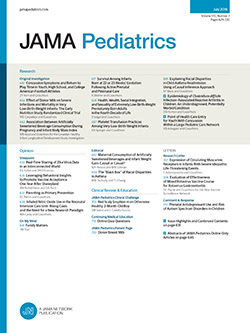急诊科青少年淋病和衣原体筛查
IF 18
1区 医学
Q1 PEDIATRICS
引用次数: 0
摘要
重要性在美国每年诊断出的250万性传播感染病例中,青少年几乎占了一半,急诊科是许多青少年医疗保健的主要来源。没有建议存在急诊科淋病和衣原体筛查。目的比较常规护理与有针对性和普遍提供的淋病和衣原体筛查方法。设计、环境和参与者:这是一项比较有效、多中心、实用的试验,采用3型混合楔形步进交叉设计,在美国6个儿科急诊科实施了大约20个月。在2021年1月至2022年9月期间就诊于急诊科的15至21岁患者包括在内,但不包括那些不懂英语、病危、担心性侵犯或性虐待、认知障碍或精神状态改变或无法提供同意的患者。在研究期间的98 413急诊科报告中,7503名青少年接受了测试。干预措施:患者完成了一项计算机化的性健康调查。在普遍提供的筛查干预中,向所有参与者提供淋病和衣原体筛查,对检测的临床决策支持仅基于患者接受检测的决定(临床医生无法获得调查结果)。在有针对性的筛查干预期间,基于患者报告的行为数据的调查得出的经过验证的风险评分被整合到电子健康记录中,为淋病和衣原体检测提供临床决策支持。通常护理阶段是指调查纳入急诊科护理之前的阶段。在常规护理、有针对性和普遍提供的筛查策略中,每2周每1000名合格患者的淋病和衣原体检出率。结果在98 413例患者就诊中,18 633例(19%)发生在常规护理阶段,41 082例(42%)发生在靶向筛查阶段,38 698例(39%)发生在普遍提供的筛查阶段。研究人群以16 ~ 18岁为主(n = 50 927[51.7%]),平均(SD)年龄为17.03(1.42)岁。共有57 013名参与者(57.9%)为女性。在常规护理阶段,1432名患者接受了检测,而靶向筛查阶段为3216名,普遍筛查阶段为2855名。与常规护理相比,人群水平的淋病和衣原体检出率在目标策略阶段(每1000名患者就诊检测感染的调整差值,2.59;95% CI, 2.46-2.73)和普遍提供的策略阶段(调整差值,1.81;95% CI, 1.67-1.94)更高。结论和相关性在这项比较有效性的试验中,在儿科急诊科使用有针对性的或普遍提供的筛查工具比常规护理具有更高的检出率,有针对性的筛查在人群水平上识别出更高的感染率。研究结果表明,在急诊科整合大规模淋病和衣原体筛查的发展过程可能是有必要的。临床试验注册号:NCT03715335。本文章由计算机程序翻译,如有差异,请以英文原文为准。
Gonorrhea and Chlamydia Screening for Adolescents and Young Adults in Emergency Departments.
Importance
Adolescents account for almost half of the 2.5 million diagnosed sexually transmitted infections in the US annually, and the emergency department functions as the primary source of health care for many adolescents. No recommendations exist for emergency department gonorrhea and chlamydia screening.
Objective
To compare usual care against targeted and universally offered gonorrhea and chlamydia screening approaches.
Design, Setting, and Participants
This was a comparative effectiveness, multicenter, pragmatic trial with a type 3 hybrid stepped-wedge crossover design implemented over approximately 20 months at 6 pediatric emergency departments in the US. Patients aged 15 to 21 years presenting to the emergency department between January 2021 and September 2022 were included, excluding those who were unable to understand English, were critically ill, were with concern for sexual assault or abuse, had cognitive impairment or altered mental status, or were otherwise unable to provide consent. Of 98 413 emergency department presentations during the study period, 7503 adolescents underwent testing.
Interventions
Patients completed a computerized sexual health survey. During the universally offered screening intervention, gonorrhea and chlamydia screening was offered to all participants, and clinical decision support for testing was based solely on the patient's decision to undergo testing (survey results were not available to clinicians). During the targeted screening intervention, a validated risk score derived from the survey based on patient-reported behavioral data was integrated into the electronic health record to provide clinical decision support for gonorrhea and chlamydia testing. The usual care phase represented the period before the survey was integrated into emergency department care.
Main Outcomes and Measures
Gonorrhea and chlamydia detection rates per 1000 eligible patients per 2-week intervals among usual care, targeted, and universally offered screening strategies.
Results
Of the 98 413 patient visits, 18 633 (19%) took place during the usual care phase, 41 082 (42%) during the targeted screening phase, and 38 698 (39%) during the universally offered screening phase. The study population was predominantly aged 16 to 18 years (n = 50 927 [51.7%]), with a mean (SD) age of 17.03 (1.42) years. A total of 57 013 participants (57.9%) were female. In the usual care phase, 1432 patients had testing ordered vs 3216 in the targeting screening phase and 2855 in the universal screening phase. Compared to usual care, population-level gonorrhea and chlamydia detection rates were higher during the targeted strategy phase (adjusted difference in infections detected per 1000 patient visits, 2.59; 95% CI, 2.46-2.73) and universally offered strategy phase (adjusted difference, 1.81; 95% CI, 1.67-1.94).
Conclusions and Relevance
In this comparative effectiveness trial, a targeted or universally offered screening tool in pediatric emergency departments was associated with higher detection rates than usual care, with targeted screening identifying higher rates of infections at the population level. The findings indicate that developing processes to integrate broad-scale gonorrhea and chlamydia screening in emergency departments may be warranted.
Trial Registration
ClinicalTrials.gov Identifier: NCT03715335.
求助全文
通过发布文献求助,成功后即可免费获取论文全文。
去求助
来源期刊

JAMA Pediatrics
PEDIATRICS-
CiteScore
31.60
自引率
1.90%
发文量
357
期刊介绍:
JAMA Pediatrics, the oldest continuously published pediatric journal in the US since 1911, is an international peer-reviewed publication and a part of the JAMA Network. Published weekly online and in 12 issues annually, it garners over 8.4 million article views and downloads yearly. All research articles become freely accessible online after 12 months without any author fees, and through the WHO's HINARI program, the online version is accessible to institutions in developing countries.
With a focus on advancing the health of infants, children, and adolescents, JAMA Pediatrics serves as a platform for discussing crucial issues and policies in child and adolescent health care. Leveraging the latest technology, it ensures timely access to information for its readers worldwide.
 求助内容:
求助内容: 应助结果提醒方式:
应助结果提醒方式:


